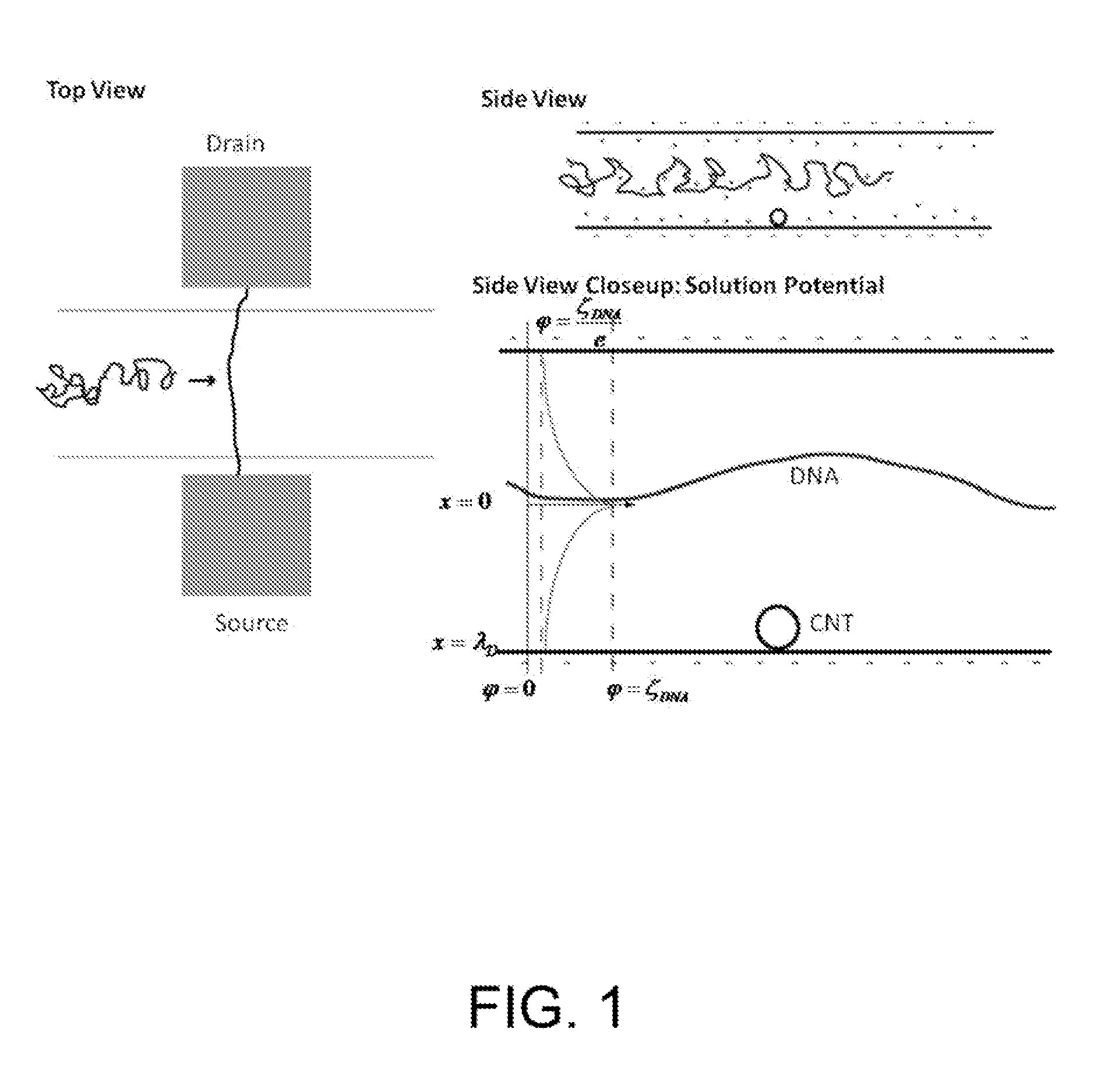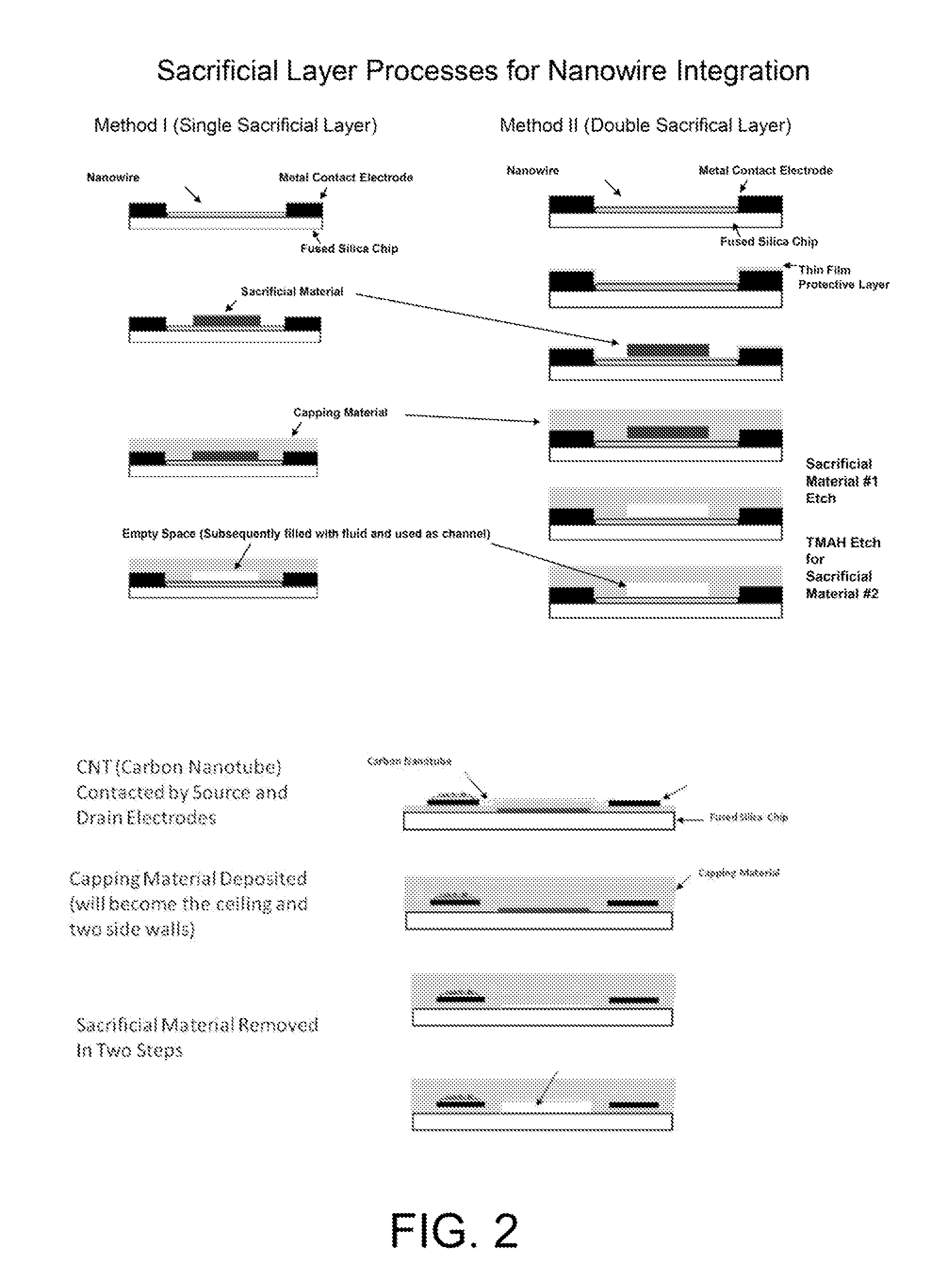Nanofluidic channels with integrated charge sensors and methods based thereon
a technology of charge sensor and nanowire, applied in the field of nanowire, can solve the problems of affecting the optical length detection measurement, difficult to functionalize certain types of nanowire at all, and shifting of nanowire conductivity,
- Summary
- Abstract
- Description
- Claims
- Application Information
AI Technical Summary
Benefits of technology
Problems solved by technology
Method used
Image
Examples
example 1
6.1 Example 1
Nanofluidic Channels with Integrated Carbon Nanotube Charge Sensors
6.1.1 Introduction
[0319]This example demonstrates that a electrical detector comprising a nanofluidic channel and a carbon nanotube sensor integrated in the nanofluidic channel can be used as means for electronically detecting charged molecules in a highly confined environment while allowing for simultaneous fluorescent observation. Subsequent Examples (Sections 6.2-6.4) describe methods for fabricating electrical detectors comprising a nanofluidic channel and a charge sensor integrated in the nanofluidic channel, wherein the charge sensor is a nanowire or nanotube.
[0320]Individually addressable, semiconducting, single-walled carbon nanotubes were incorporated into fluid-filled channels with depths of 15-100 nm and widths of 500 nm. Given appropriate buffer conditions, channels of this size are comparable in depth to the length scale of ionic screening. Thus, charged DNA molecules travelling through the ...
example 2
6.2 Example 2
Fabrication of Device Comprising a Nanofluidic Channel with an Integrated Carbon Nanotube
6.2.1 Introduction
[0381]The electrical detector described in Section 6.1 was fabricated by a method that comprised a combination of standard micro-electro-mechanical (MEMS) processing techniques known in the art, as well as carbon nanotube growth techniques well known in the art. This example describes a preferred embodiment for a method for producing nanofluidic channel devices with integrated carbon nanotube sensors.
[0382]Section 6.3 sets forth a specific embodiment of the fabrication method.
6.2.2 Device Characteristics
[0383]Based on the concepts for electrical detection of charged DNA molecules in nanofluidic channels using integrated carbon nanotubes outlined in Section 6.1, an electrical detector comprising a nanofluidic channel and a charge sensor integrated in the nanofluidic channel preferably has the following characteristics:
[0384](1) Nanofluidic channel depths are prefera...
example 3
6.3 Example 3
Detailed Protocol for Fabrication of Device Comprising a Nanofluidic Channel with an Integrated Carbon Nanotube
[0508]The following is an example of a fabrication protocol that has been carried out based on the methods for fabricating the electrical detector set forth in Section 6.2 (Example 2).
[0509]Step 1: Fabrication of Alignment Layer[0510]1. Pre-Processing:[0511]a. Obtain three, 100 mm diameter, 170 μm thick, fused silica wafers. (Mark Optics) Wafers should have a scratch dig parameter of 40 / 20 or lower, and an RMS surface roughness of [0512]b. Scribe Wafer Numbers onto back of wafers using a diamond scribe.[0513]c. Clean wafers in an automated spin-rinse-dry machine.[0514]2. Photoresist Preparation:[0515]a. p-20 primer; spin at 3000 RPM, 5000 R / S, 45 sec[0516]b. SPR 220 3.0 Photoresist; spin at 3000 RPM, 5000 R / S, 45 sec[0517]c. Bake on hotplate at 115° C. for 2 min.[0518]3. Photolithography in Autostep Mask Aligner[0519]a. Load the desired photolithography mask in...
PUM
| Property | Measurement | Unit |
|---|---|---|
| depth | aaaaa | aaaaa |
| radius of gyration | aaaaa | aaaaa |
| radius of gyration | aaaaa | aaaaa |
Abstract
Description
Claims
Application Information
 Login to View More
Login to View More - R&D
- Intellectual Property
- Life Sciences
- Materials
- Tech Scout
- Unparalleled Data Quality
- Higher Quality Content
- 60% Fewer Hallucinations
Browse by: Latest US Patents, China's latest patents, Technical Efficacy Thesaurus, Application Domain, Technology Topic, Popular Technical Reports.
© 2025 PatSnap. All rights reserved.Legal|Privacy policy|Modern Slavery Act Transparency Statement|Sitemap|About US| Contact US: help@patsnap.com



